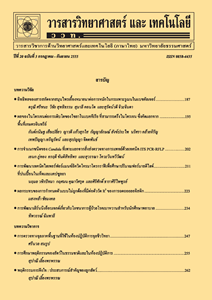ศักยภาพของพื้นที่สำหรับการปลูกข้าวและการปรับตัวของชาวนาจากปัญหาอุทกภัย ตำบลขนาบนาก อำเภอปากพนัง จังหวัดนครศรีธรรมราช
Main Article Content
Abstract
Abstract
Floods cause a significant impact on agricultural development, especially rice planting, in Southern Thailand. This study aims to assess the potential areas for rice planting and to study farmer adaptation after flooding. The potential areas for paddy field were assessed by using PSA technique (potential surface analysis) in ArcGIS 9.2. Physical factors such as soil drainage, nutrients (Nitrogen, Phosphorus, and Potassium), pH, soil texture, soil depth, and slope and salt concentration in the soil were included in order to assess the potential areas. Moreover, flood risk areas and land use information were also applied to assess the suitable areas for rice planting. The results of study indicated that only 10.91 % of total area was suitable for rice (2,630.86 rai). Additionally, high, medium, and low potential areas were 3.27, 4.77, and 2.87 %, respectively. The most area (89.09 %) in this study area was identified as no potential for rice planting which was about 21,477.57 rai. The highest potential areas are in moo 3 (approximately 541.24 rai) and other suitable zone are in moo 1 and moo 4, whilst, no potential areas are in moo 2, moo 5, moo 6, moo 7, moo 8, moo9 and moo 10. Flooding problems strongly reduce suitable areas for rice planting. In this study, the opinion of a farmer in terms of adaptation after flooding was conducted using a questionnaire and group meeting methods. The results showed that 94.45 % of farmers in the Khanap Nak have no adapted strategies for rice planting. They still do rice farming with a same previous plan, i.e. waiting for rainwater before planting the rice. The most farmers (77.48 %) produce rice both for consuming and trading, whilst only 16.67 % use rice productions for consuming in their family. Interestingly, more than 90 % of total farmers in the study areas have no plan to manage their crops affected by flooding. This is possible because farmers are quite old. This group of farmer just waits for support from the government without their own plan. There are a few farmers (5.55 %) have changed the way to land use for other plants such Nypa palm and palm oil. The farmers have plans for managing flooding problems, both on individual and communal levels. For individual level, farmers planned to construct elevated ridges protecting paddy from flooding. They also planned to release water from the crop by connecting personal drainage with common water pools. For communal level, not only construct elevated ridges and manage the drainage system but also selecting the rice species that resist to climate change and grow better in areas, where are low water supplies.
Keywords: paddy; geographic information system (GIS); farmer adaptation; flood
Article Details
References
[2] สำนักงานเกษตรอำเภอปากพนัง, 2560, รายชื่อเกษตรกรจำแนกตามกิจกรรมการเกษตร, กรมส่งเสริมการเกษตร กระทรวงเกษตรและสหกรณ์, นครศรีธรรมราช.
[3] สำนักงานรพัฒนาเทคโนโลยีอวกาศและภูมิสารสนเทศ (องค์การมหาชน), Thai Flood Mornitoring System, แหล่งที่มา : http:// flood.gistda.or.th, 5 พฤษภาคม 2560.
[4] วัลภา อินทรงค์, 2555, การวิเคราะห์พื้นที่เหมาะสมเพื่อการอนุรักษ์พันธุ์ข้าวสังข์หยด จังหวัดพัทลุง, วิทยานิพนธ์ปริญญาโท, มหาวิทยาลัยศรีนครินทร์ทรวิโรฒ, กรุงเทพฯ, 68 น.
[5] Yamane, Taro, 1967, Statistics, An Introductory Analysis, 2nd Ed., Harper and Row, New York.
[6] สุวรรณา ตุลยวศินพงศ์, 2559, น้ำท่วม-น้ำแล้งกับการปรับตัวของเกษตรกรในลุ่มน้ำเจ้าพระยา, สถาบันวิจัยเพื่อพัฒนาสิ่งแวดล้อมไทย (ทีดีอาร์ไอ), กรุงเทพฯ, 28 น.
[7] ทรงชัย ทองปาน, 2556, กลยุทธ์การปรับตัวของเกษตรกรทำนา ในพื้นที่น้ำท่วมซ้ำซาก อำเภอชุมแสง จังหวัดนครสวรรค์, ว.ปาริชาติ 3(ฉบับพิเศษ): 79-89.
[8] สมพร คุณวิชิต, ยุพิน รามณีย์ และบัญชา สมบูรณ์สุข, 2558, การเปลี่ยนแปลงสภาพภูมิอากาศกับวิถีชีวิตของมนุษย์ : ศึกษาผลกระทบและการปรับตัวของเกษตรกรผู้ปลูกข้าวในพื้นที่ลุ่มน้ำทะเลสาบสงขลา, คณะการจัดการสิ่งแวดล้อม มหาวิทยาลัยสงขลานครินทร์, สงขลา, 164 น.

